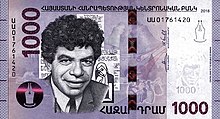You can help expand this article with text translated from the corresponding article in Armenian. (17 September 2024) Click for important translation instructions.
|
| Paruyr Sevak | |
|---|---|
 | |
| Born | Paruyr Ghazaryan (1924-01-24)January 24, 1924 Chanakhchi, Transcaucasian SFSR, Soviet Union |
| Died | June 17, 1971(1971-06-17) (aged 47) Yerevan, Armenian SSR, Soviet Union |
| Resting place | Zangakatun, Armenia |
| Nationality | Armenian |
| Period | 1940s-1971 |
| Notable works | "We Are Few But We Are Called Armenians," "The Unsilenceable Belfry," "Man in a Palm," "Immortals Command" |
| Spouse | Maya Avagyan, Nelli Menagharishvili |
Paruyr Sevak (Armenian: Պարույր Սևակ; January 24, 1924 – June 17, 1971) was an Armenian poet, translator and literary critic. He is considered one of the greatest Armenian poets of the 20th century.
Biography
Sevak was born Paruyr Ghazaryan (Armenian: Պարույր Ղազարյան) in the village of Chanakhchi (now Zangakatun), Armenian SSR, Soviet Union to Rafael and Anahit Soghomonyan on January 24, 1924. His ancestors had migrated to Chanakhchi, a remote, mountainous village, from the village of Havtvan in Salmast (Salmas), Iran in 1828. Young Paruyr attended the village school, where he wrote his first poems and published them in the school wall newspaper. Sevak spent part of his childhood and adolescence in a location called Navchalu yayla near his native village; in his early writings, he signed his writings with 'Navchalu' as the location where they were written. In 1939, he became a student at the philological faculty of Yerevan State University. He graduated in 1945. The same year he started his postgraduate studies in Armenian literature at the Abeghyan Institute of Literature of the Armenian SSR Academy of Sciences, which lasted until 1948. In 1951, Sevak went to Moscow to study at the Gorky Institute of World Literature. After graduation, he worked there as professor of translation in 1957-59.
In 1960 Sevak returned to Yerevan and resumed his prolific and meaningful literary, scientific and public career. He started to work at the Abeghyan Institute of Literature as a scientific researcher. From 1966-1971 Sevak served as secretary on the Board of the Writers Union of Armenia.
In 1967 Sevak became a doctor of philology after his dissertation defense. In 1968 he was elected to the Supreme Council of the Armenian SSR.

Sevak died on June 17, 1971, in a car crash while on a drive back to Yerevan. In previous years, he had voiced his criticism of the cultural policies of the Soviet government and for this, many Armenians believe, he was murdered by the Soviet government. His wife, Nelly Menagharishvili, also died in the car crash. He was buried in the backyard of his home, in Zangakatun, which later became a museum open to everyone.
Literary work
Sevak's long poem Anlr’eli zangakatunë (The Incessant Bell-tower) is dedicated to Armenian composer Komitas and to the memory of the Armenian genocide.
Publications
- (1948) Anmahnerë hramayum en (Անմահները հրամայում են (The immortals command))
- (1953) Anhasht mtermut’yun (Անհաշտ մտերմություն (Irreconcilable intimacy))
- (1954) Siro chanaparh (Սիրո ճանապարհ (Path of love))
- (1969) Yeghits’i luys (Եղիցի լույս (Let there be light)
- (1971) Dzer tsanot’nerë (Ձեր ծանոթները (Your acquaintances))
- (1972–1976) Yerkeri zhoghovatsu vets’ hatorov (Երկերի ժողովածու վեց հատորով (Collected works in six volumes))
- (1982–1983) Yerker: zhoghovatsu yerek’ hatorov (Երկեր ։ ժողովածու երեք հատորով (Collected works in three volumes))
Translations into English
- Selected Poems. Translated with an introduction by Garig Basmadjian. Jerusalem: St. James Press, 1973.
- Paruyr Sevak's Poetry: Select Translations from Armenian. Translated by Jack Aslanian. Yerevan: VMV-Print, 2011.
- The Incessant Bell-tower. Translated by Svetlana Vardanian. Yerevan: Limush Press, 2015 (2nd revised ed.: 2017).
Legacy and memory

One of the main streets of Yerevan's Kanaker-Zeytun District is named after Sevak. School #123 of Yerevan is named after Paruyr Sevak.
On 2018, the third series of Dram banknotes were printed, featuring Sevak on the 1000 Dram note.
In popular culture
- Paruyr Sevak (1984), film directed by Levon Mkrtchyan, Armenfilm
Notes
- Sevak's date of birth is incorrectly recorded as January 26 in various sources and official documents. Since he was born during the mourning ceremonies following the death of Vladimir Lenin, his birth was recorded two days late.
- Instead of receiving his father's surname, Soghomonyan, Paruyr received the surname Ghazaryan, formed from his paternal grandfather's given name.
- Yayla is a word of Turkic origin meaning 'highland' or 'mountain pasture'.
References
- Portraits of hope: Armenians in the contemporary world, by Huberta von Voss - 2007 - p. 116
- ^ Gasparyan, Davit (2001). Paruyr Sevak: Kyankʻě ev steghtsagortsutʻyuně Պարույր Սևակ․ Կյանքը և ստեղծագործությունը [Paruyr Sevak: life and work] (in Armenian). Yerevan: Nor dar. p. 24. ISBN 99930-64-68-8.
- ^ Gasparyan 2001, p. 25.
- Ghulyan, Husik (December 1, 2020). "Conceiving homogenous state-space for the nation: the nationalist discourse on autochthony and the politics of place-naming in Armenia". Central Asian Survey. 40 (2): 257–281. doi:10.1080/02634937.2020.1843405. ISSN 0263-4937. S2CID 229436454.
- Gasparyan 2001, pp. 25–26.
- ^ Կենսագրություն (in Armenian). ParuyrSevak.com. Retrieved August 3, 2012.
- Malkasian, Mark (1996). Gha-ra-bagh!: The Emergence of the National Democratic Movement in Armenia. Detroit: Wayne State University Press. p. 215. ISBN 9780814326046.
- "Sevak St, Yerevan, Armenia". Google Maps. Retrieved August 2, 2012.
- "Yerevan Basic School №123 named after Paruyr Sevak". Spyur.am. Retrieved August 2, 2012.
External links
- Poems by Paruyr Sevak on Sevak.am (in Armenian)
- Audio recordings of Sevak's poems on Freebooks.do.am
- 1924 births
- 1971 deaths
- 20th-century Armenian poets
- 20th-century pseudonymous writers
- People from Ararat Province
- Yerevan State University alumni
- Seventh convocation members of the Supreme Soviet of the Soviet Union
- Recipients of the Order of the Red Banner of Labour
- Recipients of the USSR State Prize
- Armenian male poets
- Soviet Armenians
- Soviet male poets
- Road incident deaths in Armenia
- Road incident deaths in the Soviet Union